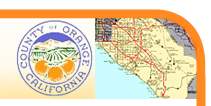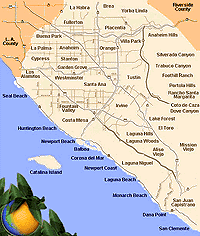|
THE
HISTORY
Men
and women of vision carved cities from Orange
County's beaches, ranchos and farmland.
The
county's earliest settlement, Mission San Juan
Capistrano, was founded in 1776. The mission eventually
added commerce, trading locally prepared hides
and tallow for books, furniture and other supplies
from the East Coast.
The
entrepreneurs who followed saw riches in Orange
County's good soil, wide expanses of range and
pristine beaches. Settlers and farmers built homes,
churches and schools - the foundation of 27 cities
to come.
The
first cities - Anaheim, Santa Ana and Orange,
incorporated between 1876 and 1888.
W.H.
Spurgeon investigated the area, bought 74 acres
and laid out what would become the town center
of Santa Ana, selling downtown lots to investors
for $15 each in 1870.
Two
lawyers, Alfred Beck Chapman and Andrew Glassell,
took 1,385 acres of land in lieu of a legal fee
and turned it into a town originally called Richland,
then renamed Orange. The town soon became a fruit
packing and shipping center.
George
Hansen, representing a group of German settlers,
bought the land along the Santa Ana River that
was to become Anaheim. Hansen
planted 400,000 grape vines, turning the area
into a major wine and brandy producer. A century
later, Anaheim would become known as the home
of Disneyland and Mickey Mouse.
The
rich soil in northern and central Orange County
produced barley
wheat, grapes, walnuts, oranges and lemons. Dairy
farms prospered in what would become Cypress and
La Palma.
To
the south, Dana Point and Newport Beach became
busy harbors. Cattle and sheep roamed the wide-open
ranchos of inland south county.
In
the early 1900s, Huntington Beach landowners discovered
oil, and films stars discovered Laguna Beach,
first as a film locale and then as a convenient
getaway.
The
real boom in Orange County population followed
World War II. After
the war, farmland was replaced by houses in the
county's northern, central and western areas,
giving rise to the cities of Fountain Valley,
Costa Mesa and Los Alamitos.
The
Growth eventually spread south, transforming still-rugged
ranch land and productive farmland into housing
tracts in the late 1960s. Now, the county's newest
cities are forming in the maturing communities
of the south county.
|



![]()


